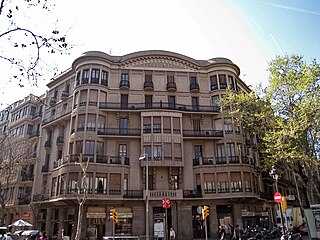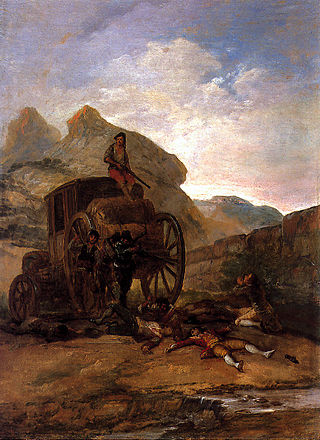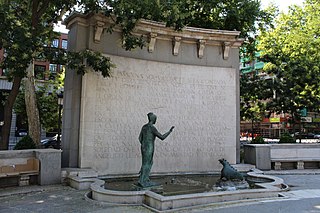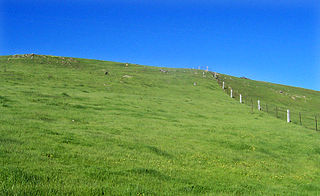
Joaquín Turina Pérez was a Spanish composer of classical music.

Santiago Rusiñol i Prats was a Catalan painter, poet, journalist, collector and playwright. He was one of the leaders of the Catalan modernisme movement. He created more than a thousand paintings and wrote numerous works in Catalan and Spanish.

Eugeni d'Ors Rovira was a Spanish writer, essayist, journalist, philosopher and art critic. He wrote in both Catalan and Spanish, sometimes under the pseudonym of Xènius.

Noucentisme was a Catalan cultural movement of the early 20th century that originated largely as a reaction against Modernisme, both in art and ideology, and was, simultaneously, a perception of art almost opposite to that of avantgardists. In 1906, Eugeni d'Ors coined the term following the Italian tradition of naming styles after the centuries and using the homonyms nou (nine) and nou (new) to suggest it was a renovation movement. The same year two essential works for Noucentisme were published: Els fruits saborosos by Josep Carner and "La nacionalitat catalana" by the Conservative politician Enric Prat de la Riba.

Mariano Andreu (1888–1976) was a Spanish painter, drawer, enamelling master, sculptor, and stage designer.

Ors is a commune in the Nord department in northern France.

Laurent Lefèvre is a French former professional road bicycle racer, last for UCI Professional Continental team Bbox Bouygues Telecom. He is one of only three Festina team riders who was named as being clean in the Festina doping affair in the 1998 Tour de France. He is the brother of racing cyclist David Lefèvre and the cousin of racing cyclists Olivier Bonnaire and Marion Rousse.

Carles Fages de Climent was a writer, poet and journalist from the Empordà, a historical region of Catalonia, Spain. He was born in Figueres on May 16, 1902. In Figueres' high school, he met Salvador Dalí, starting a friendship that would last all their lives.

The Portrait of Sebastián de Morra is a painting by Diego Velázquez of Sebastián de Morra, a court dwarf and jester at the court of Philip IV of Spain. It was painted around 1644 and is now in the Prado in Madrid. Not much is documented about De Morra's life, other than the fact that he was brought to Spain by Philip IV in 1643 and served the court for six years before his death in 1649. It was not until Velázquez became a court painter that he showed dwarfs with a warmer and naturalistic style compared to previous paintings. De Morra looks directly at the viewer, motionless, making no hand gestures, leading one critic to suggest that the painting represents a denunciation of the court's treatment of de Morra and other dwarfs. Recently discovered inventories and previous documents relating to De Morra reveal that he was also known by a nickname, El Primo.
Rafael Domingo Oslé is a Spanish legal historian and professor of law.
Diego Lara (1946–1990) was a Spanish painter and graphic designer.

Carles Buïgas i Sans was a Catalan architect, engineer, inventor and author.

Enrique García-Máiquez and always living in El Puerto de Santa María), is a Spanish poet: he has published four poetry books. He also writes essays, articles on literary criticism and newspaper columns. He is married and has one daughter.

Álvaro Jordi d'Ors Pérez-Peix was a Spanish scholar of Roman law, currently considered one of the best 20th-century experts on the field; he served as professor at the universities of Santiago de Compostela and Pamplona. He was also theorist of law and political theorist, responsible for development of Traditionalist vision of state and society. Politically he supported the Carlist cause. Though he did not hold any official posts within the organization, he counted among top intellectuals of the movement; he was member of the advisory council of the Carlist claimant.

Guillaume Gélinas is a retired Canadian professional ice hockey defenceman. He last played for UK Elite Ice Hockey League (EIHL) side Belfast Giants in Northern Ireland.

Juan d'Ors was born in Madrid, Spain, December 8, 1957. His grandfather was the philosopher and art critic Eugenio d'Ors. He is the son of Juan Pablo d'Ors Pérez, a humanist doctor, and María Luisa Fuhrer, a philologist. He is a singer, musician, actor, writer, film-maker, and "Tintin" expert ("Tintinologist").

The Martyrdom of Saint Philip is a painting by Jusepe de Ribera from 1639.

Assault of Thieves is an oil painting made by the Spanish artist Francisco de Goya between 1793 and 1794. It is part of a private collection owned by Juan Abelló.

The Monument to Eugenio d'Ors Rovira is an instance of public art in Madrid, Spain. Dedicated to Eugenio d'Ors—noted Catalan writer, art critic and Francoist intellectual—it consists of a sculptural group put inside a fountain and a commemorative wall displaying a relief of d'Ors. It lies at the middle of the Paseo del Prado, facing both the Casa Sindical and the Prado Museum.

In Roman law, the praedial servitude or property easement, or simply servitude (servitutes), consists of a real right the owners of neighboring lands can establish voluntarily, in order that a property called servient lends to other called dominant the permanent advantage of a limited use. As use relations, servitudes are fundamentally solidary and indivisible rights, the latter being what causes the servitude to remain intact despite the fact that any property involved may be divided. Furthermore, there is no possibility of acquisition or partial extinction.


















